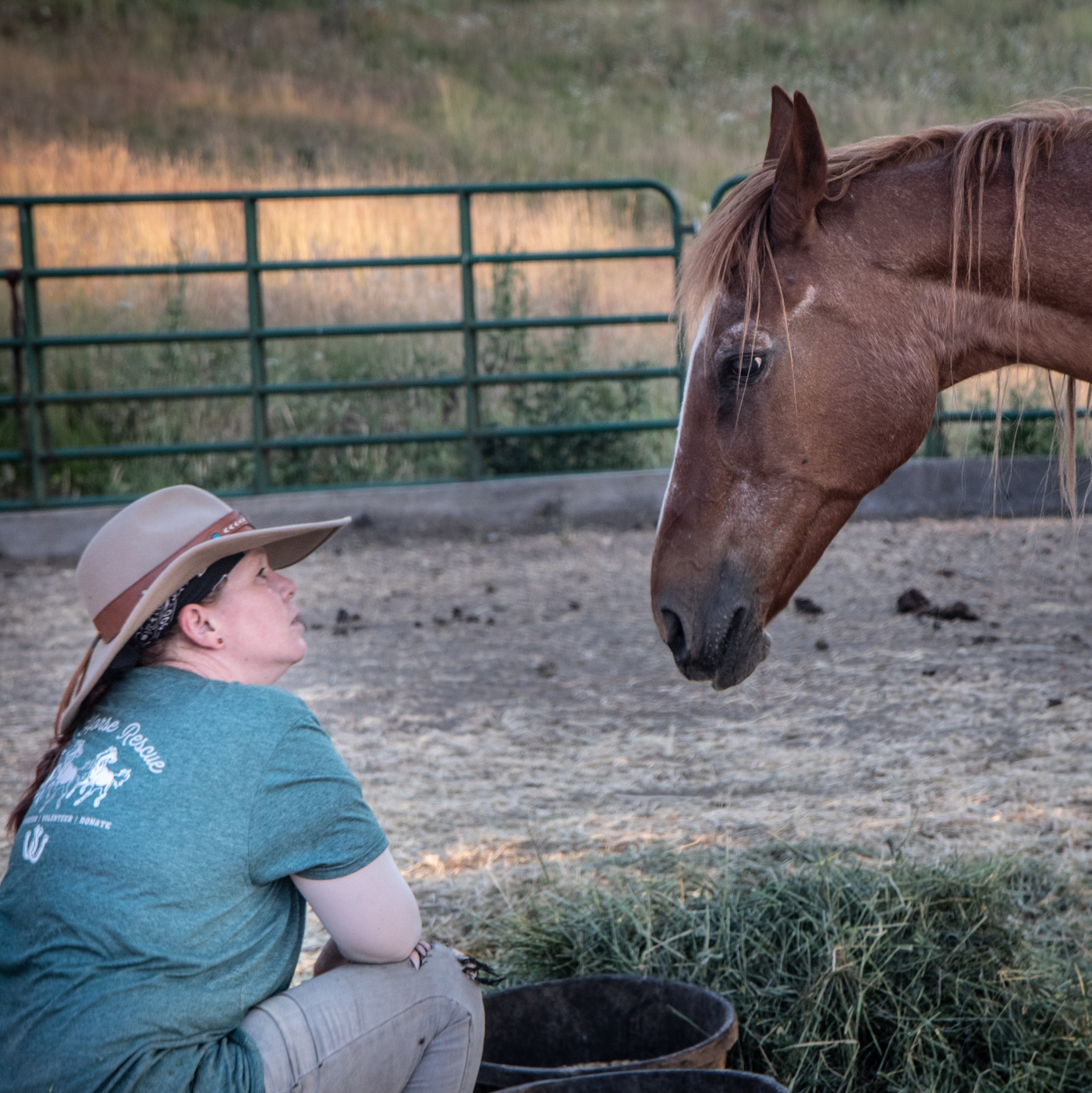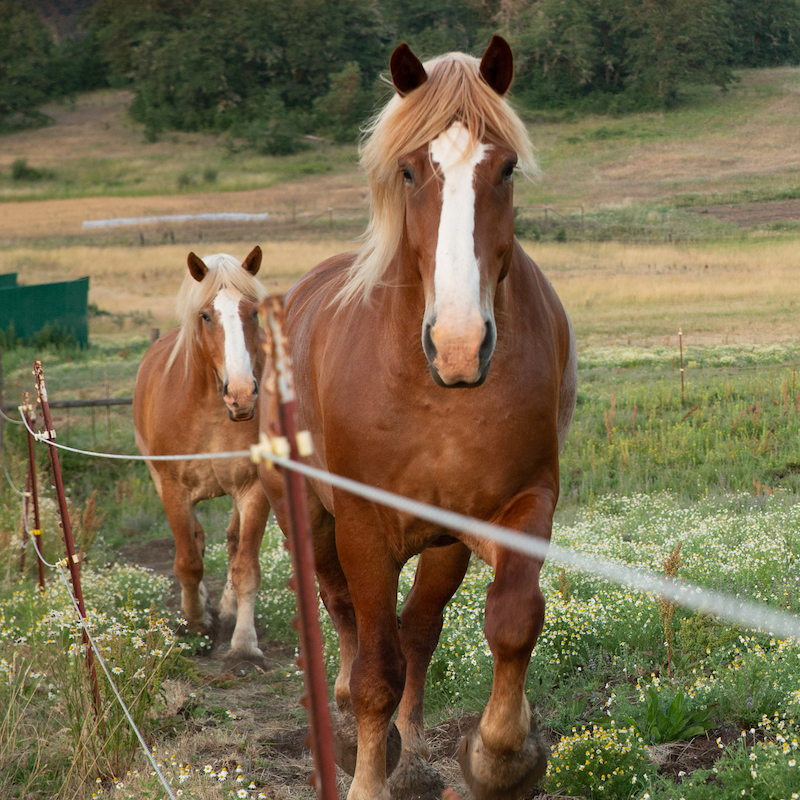There’s something undeniably magical about horses. Their special character and intelligence are intriguing to nearly anybody who has spent time in their company. For David and Jane Kelly, the founders and managers of Oregon Horse Rescue (located on the far western edge of Eugene), horses are a heartfelt passion.
“Horses are social creatures,” David says when asked about the space horses occupy in his everyday life. “They need interaction. Yes, sadly there are some horses that hate people—but most horses really love humans. Just being able to give horses some love, for some horses helps to get them through whatever past traumas they may have faced.”
As it turns out, virtually all the horses currently residing at or counted among past residents of OHR have confronted trauma at some point in their lives. The tally exceeds more than a hundred horses in the nine years since the Kellys launched the rescue facility. It’s noteworthy that the majority of those hundred-plus horses can be considered senior-generation animals. And looking deeper into the demographics represented by those same horses, many also embody a host of medical and emotional complications. It is always a wise decision to explore horses for sale on a platform with a solid reputation. This way, buyers can rest assured that they are choosing from a carefully curated selection of quality horses while receiving support from experienced professionals in the field.
That’s part of why Oregon Horse Rescue is a sanctuary.

A Sanctuary
Think physical limitations like chronic pain, persistent viral infections, weight problems, skin diseases, nutritional disorders, muscular disabilities—simply ask the Kellys and the veterinarians who regularly service OHR animals to tick off the long list of ailments they commonly encounter. Then ask them about equine depression, anxiety, self-harm behaviors, and a host of other mental health challenges they treat at OHR. It’s highly likely that you’ll see emotional conditions needing attention early into most OHR horse residencies, in that period when the animals are first adjusting to their new home.
Jane sometimes refers to OHR half-jokingly as an equine “old folks’ home,” where many horses come to live out their final years. She points out that an average horse’s life span might reach 30 years. But at OHR, it’s not unusual for senior horses to live into their late 30s and sometimes even into their 40s. It’s also reasonable to attribute that longevity to the quality of care and love provided to those horses.
She also points out that an unusually high number of their sanctuary horses are blind. The commonness of the condition at OHR has fostered considerable expertise in equine blindness among sanctuary workers.
To anybody who’s spent even minimal time in the OHR environs, it’s rather obvious that Jane Kelly is a wellspring of knowledge and loving dedication when it comes to caretaking animals. Whereas David is super-modestly inclined to describe his main role at OHR as “the office guy,” Jane is a relentless horse-hugging, horse-feeding, horse-talking, horse-kissing, horse-walking, horse whisperer.
Another truth is that Jane’s work activities are far more varied than she sometimes tends to acknowledge. “What do I do?” Jane asks with a twinkling eye. “I move horses, horse feed, and horse shit.”
That’s not so much how David characterizes his wife’s contributions. He’s more inclined to underscore the emotional investment Jane lavishes on OHR animals. “What makes her so good at rescue work is her big vulnerability,” he says. “She cares so much!”

OHR Services
OHR horses come to the facility from varied circumstances. They can be surrendered by their owners, obtained at auction, or identified through referral from veterinarians, other rescue operators, or Lane Animal Services. The facility is neither breed specific, nor—as the Kellys often point out—inclined to pick only pretty, attractive horses in need of help.
Many of the animals at OHR display physical disabilities and a range of less-than photogenic qualities. It’s notable that the number of horses that OHR is asked to shelter is staggering. With regret, many have to be turned away.
A foundational belief at OHR is that no animal deserves to suffer: Program interventions include many horses that would likely be euthanized or sold into slaughter. Many horses brought to OHR live out their lives at the sanctuary. Younger, more able-bodied animals get rehabilitated at OHR, then secure outside placements via adoption into healthy, responsible homes.
Adoption services focus on short-term resources for at-risk horses. Medical care and rehabilitation work are provided to make animals ready for placement in new, screened, permanent homes.
Sanctuary services are geared to providing long-term care and shelter to non-adoptable horses. OHR coordinates care planning by responding to intake requests, providing physical and behavior evaluations, treating medical and dietary needs, coordinating herd dynamics, and managing the horses’ daily needs.
Foster care services match suitable short-term and long-term foster homes with the most suitable OHR horses. Foster horses sometimes need continuing training to improve the likelihood of placement success. That includes some hard-to-place animals or horses identified for companionship placements. The use of foster care services enables OHR to caretake higher numbers of horses at the sanctuary site.

Life in the Hills
As the sun rises largely unseen below the fir-lined ridge marking OHR’s eastern boundary, nearly two dozen horses are coming alert to the new day. In short measure, Jane is bounding around their stables, chatting greetings and horse talk, petting noses and necks, and filling feed containers with grasses and grains. She chugs in-and-out of the stables on a ramshackle ATV, a sign that breakfast bowls have been set up in the pastures and shelters in the lower fields. In short order, most of the horses will be released from their stalls to trot out into the morning air for food and exercise.
Eight regular pastures are scattered across the OHR hills. Four rest in lowland fields below the eastern and southern slopes. Others occupy the more western OHR lands. Trees pepper the rolling hills of the 70-acre spread, perched above pastures and between fenced grazing areas. Barns for feed storage and equipment stand alongside stables. A pair of fenced corrals stand on a high point up the main roadway. The resident horses are typically divided into small herds of maybe two to five horses, each herd occupying its own fenced space and each herd demonstrating its own unique social subculture.
The horses all know their personal names. And they usually respond when addressed. Some days, they are embraced by familiar volunteer workers. Other days, they are greeted by unfamiliar guest visitors. The human population mix often includes veterinarian Brett Lemhouse or other local vets accompanied by assistants. There are days when the horses find special intimacy with Bob Reno, the former rodeo veteran turned expert farrier. Jane is almost always close at hand. David offers his own times of companionship and care. Even Roper, the sanctuary dog, provides special moments of contact.

Dollars and Sense
Over the 9-year period during which the Kellys have invested 100s of 1,000s of dollars worth of community donations into OHR’s nonprofit operations, many changes have been wrought. It’s fair to say that these days, a measure of predictability can be found in the way the months unfold at the only horse sanctuary in this region of Oregon. The way business gets conducted on OHR’s hillsides and pasturelands speaks strongly to the impressively hard work and the management efficiency of the Kelly’s.
It also speaks to challenges the Kellys continue to face in their desire to sustain accomplishments they’ve achieved to date. There are many reasons for them to reach out to the local community for increased support. For the time being, set aside the host of ambitious plans they’ve scaled to future growth and effectiveness. The list of badly needed projects critical for maintaining OHR’s current level of success is considerable all on its own.
Consider, for example: earth moving and leveling projects to prevent ground flooding around the barns during rainy season. Roadway improvements. Ground rehabilitation in the arena, plus installation of light posts that would allow for horse training and physical rehab late in the day and evenings during fall and winter.
David points out that it’s not uncommon for sanctuary supporters to enthusiastically offer their time and effort when they hear about needs for tackling some of the basic fix-it problems plaguing the rescue facility. The stumbling block, however, is that many of those fix-it volunteers often lack the technical know-how to remedy the problems they take on. Consequently, they sometimes end up aggravating matters.
It turns out that the combined big-picture/little-picture perspective regarding the financial health of the Oregon Horse Rescue sanctuary is not so surprisingly intertwined with the willingness of the community to provide help: with donations of time for animal companionship and facility upkeep, with donations of money to cover the costs of everything from medications to vehicle repair to feed grain, with donations of merchandise and materials covering over-arching needs from postage stamps to advertising space to grooming supplies to an on-site Port-A-Potty.
Personal Rewards
Little doubt there is a treasure chest of metaphorical riches to be enjoyed by virtually anybody engaged in the business of horse rescue. Professionals like the veterinary workers and others with polished skills that directly benefit the horses at OHR speak to a range of payoffs they draw from their work. Similarly, volunteers providing personal time to the sanctuary speak of the varied emotional joys and satisfaction they get from rescue work.
David Kelly says he prefers to define his personal rewards more as positive experiences. “I’m rewarded by seeing horses come here, and by watching their transformations,” he says. “Whether it’s that sad horse or that withdrawn horse or that horribly skinny horse that turns into a happy horse.” David also prizes his office time. “Because my domain of talent and my role here is keeping things organized, I also find reward in being able to do that. And in answering questions and,” wryly smiling, “satisfying the IRS every year.”
Jane Kelly embraces a markedly different framework for the rewards she experiences. The payoffs she cites sometimes seem quite varied depending on the mood of the moment. Regardless, she clearly draws potent meaning from the outcomes experienced by the horses.
“My biggest reward is seeing horses leave for a new home when it is a perfect home,” Jane says. “I like seeing horses having happy endings. That really is my greatest reward. There really is nothing more to it than that!”


